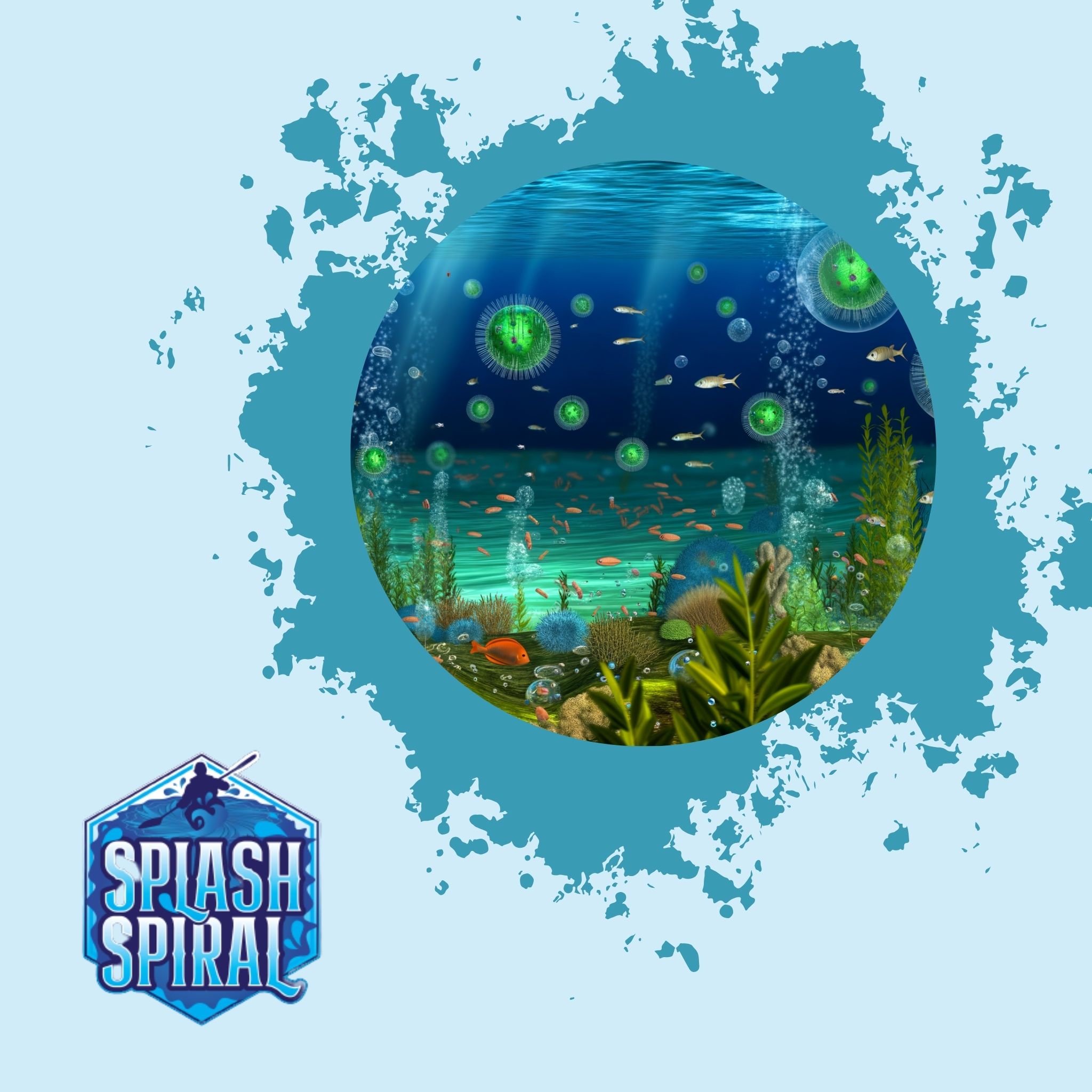
Understanding the unseen players in our oceans can profoundly shift our perception of marine ecosystems. Marine viruses, often overlooked, are essential actors in oceanic processes, influencing everything from microbial dynamics to global climate regulation. This guide breaks down their roles, impacts, and significance.
Introduction
Marine viruses might seem like small-time troublemakers compared to the bigger marine creatures you're used to hearing about, but these microscopic entities play a massive role in our oceans. They are, in fact, one of the most abundant and influential components of ocean ecosystems. Far from being just tiny pests, marine viruses are key players in shaping the dynamics of marine life and influencing global climate patterns.
Understanding marine viruses opens up a world of insight into how our oceans function. For those of you just starting out in diving or considering it, grasping the significance of these unseen entities can enrich your appreciation of marine environments. You might start to see the ocean not as a mere backdrop for your diving adventures but as a finely-tuned system influenced by even the smallest life forms.
Why should we be interested in marine viruses? In the vast, mysterious blue, they regulate the populations of microorganisms, play a crucial role in nutrient cycling, and contribute to the ocean's role in carbon sequestration. Studying them can lead to groundbreaking advancements in environmental science, offering clues about climate regulation and biodiversity that are critical for conservation efforts.
So, whether you're gearing up for your next dive or simply curious about ocean life, this guide will dive deep into the world of marine viruses, shedding light on their untold significance and broad impact on our planet.
Marine Viruses: What Are They?
Marine viruses are tiny, often invisible entities that thrive in the ocean. They're not quite what you might think of when you hear the word "virus"—like those that make you sick. Instead, marine viruses are a diverse group of microscopic particles that infect marine organisms, particularly microorganisms like bacteria and phytoplankton.
So, what exactly are marine viruses? They consist of genetic material (either DNA or RNA) enclosed in a protein coat. Unlike living cells, viruses can't replicate on their own. They need to hijack the cellular machinery of a host to reproduce. For marine viruses, these hosts are almost always some of the smallest players in the ocean, such as bacteria and single-celled algae.
One of the most surprising things about marine viruses is their sheer abundance. Imagine scooping up a single teaspoon of seawater. Inside that teaspoon, you'll find millions of these tiny viral particles. They're everywhere, in every ocean, at every depth. This makes them one of the most abundant biological entities on Earth.
To put it in perspective, if you lined up all the marine viruses end to end, they could stretch from Earth to the closest star beyond our solar system and back—multiplied several times over. That's a lot of viruses!
In summary, marine viruses are small but mighty components of the ocean. They are exceptionally abundant, numbering in the millions per teaspoon of seawater, and they play a crucial role in the marine environment by interacting predominantly with microorganisms. Understanding these tiny entities is the first step in grasping the broader dynamics of oceanic ecosystems and their impact on our planet.
The Role of Marine Viruses in Ocean Ecosystems
Marine viruses thrive in the unseen depths of the world's oceans, playing pivotal roles that might not be apparent at first glance. But their influence on ocean ecosystems is immense and multifaceted.
First, marine viruses primarily impact microorganisms, such as bacteria and algae, through a process known as lysis. When a virus infects a host, it replicates within the cell until it bursts, releasing new viral particles. This lysis not only controls microbial populations but also liberates organic matter back into the water, a process critically important for nutrient cycling. Essentially, marine viruses help decompose living matter, making nutrients available for other marine life. This is a crucial piece in the ocean's nutrient puzzle, ensuring the flow of essential elements like nitrogen and phosphorus throughout marine ecosystems.
Moreover, the role of marine viruses extends to regulating energy flow. When microbial populations are lysed, the resulting organic matter becomes food for other microorganisms. This continuous conversion keeps energy moving up the food chain, supporting a vast array of marine life from tiny plankton to larger predatory fish. Simply put, without marine viruses, the base of the oceanic food web would falter, leading to cascading impacts on higher trophic levels.
Another significant aspect is their role in controlling algal blooms. Algal blooms can sometimes become harmful, drastically altering the aquatic environment and depleting oxygen levels. Marine viruses naturally curb these blooms by infecting and lysing algal cells, thus preventing the overgrowth that could otherwise create dead zones and disrupt marine life.
In summary, marine viruses may be microscopic, but their presence ensures the stability of ocean ecosystems. They maintain microbial balance, drive nutrient cycling, and keep energy flowing through the marine food web. Understanding these roles highlights the interconnectedness of oceanic processes and underscores the importance of these tiny but mighty players in our aquatic environments.
Marine Virus Ecosystem Impact
Marine viruses, though microscopic, play a gargantuan role in maintaining the balance of marine ecosystems. These viral entities significantly influence various ecological processes and help sustain ocean health. They achieve this by interacting with microorganisms, particularly bacteria, which are critical to nutrient cycling and energy flow in marine environments.
One of the primary impacts of marine viruses is their regulation of microbial populations. By infecting and lysing bacteria, viruses control bacterial abundance, preventing any single species from dominating the ecosystem. This process, known as the "viral shunt," redirects organic matter back into the microbial loop rather than allowing it to ascend the food web. Consequently, nutrients remain available for a broader range of organisms, ensuring a balanced ecosystem where no single organism can overrun the others.
Moreover, marine viruses contribute to marine productivity by facilitating nutrient cycling. When viruses lyse bacteria, they release a wealth of organic matter and nutrients, such as nitrogen and phosphorus, into the surrounding water. These nutrients are then readily available for uptake by other microorganisms, fueling another cycle of growth and maintaining a dynamic equilibrium within the ecosystem.
In addition to regulating bacterial populations and nutrient cycling, marine viruses also play a crucial role in combating algal blooms. Algal blooms, when unchecked, can lead to detrimental effects such as hypoxia (lack of oxygen) in the water, which can decimate marine life. Viruses can infect and terminate these bloom-forming algae, curbing their growth and mitigating potential ecological disasters.
In essence, marine viruses are custodians of ocean health, fine-tuning the balance of marine life through their interactions with bacteria and other microorganisms. For beginner divers and enthusiasts, understanding the impact of these unseen forces enhances appreciation and respect for the delicate and intricate web of life beneath the water's surface.
Connection Between Marine Viruses and Climate Regulation
Marine viruses play a critical role in the carbon cycle, which is essential for regulating the Earth’s climate. These tiny entities are like the ocean’s janitors, constantly breaking down larger organisms and recycling organic materials. When marine viruses infect and lyse (break open) cells, a process known as viral lysis, they release a significant amount of organic matter back into the ocean. This organic matter, mainly in the form of dissolved organic carbon, sinks into the deep ocean, effectively sequestering carbon away from the atmosphere.
Here’s why this matters: The process helps reduce greenhouse gases in the atmosphere, thereby playing a fundamental part in mitigating climate change. By ensuring that carbon is stored in the ocean rather than released back into the air, marine viruses help to regulate global temperatures.
Beyond their role in carbon sequestration, marine viruses also influence the ocean's food web. They control the population of bacteria and other microorganisms which are key players in the marine carbon cycle. When viruses infect these microorganisms, they help keep their populations in check, preventing harmful algal blooms that could otherwise release large amounts of carbon dioxide into the atmosphere.
In summary, marine viruses are unsung heroes of climate regulation. They contribute to the balance of carbon in the ocean, influencing global climate patterns. Their actions highlight the interconnected nature of life on Earth and underscore the importance of understanding even the smallest players in our vast oceanic ecosystems. So, as you dive and explore the underwater world, remember that these microscopic entities are silently working to keep our planet's climate in check.
Marine Virology: A Growing Field of Study
The field of marine virology, though relatively young, is burgeoning with exciting discoveries and advancements. It wasn't too long ago that marine viruses were little more than footnotes in oceanographic studies, but modern research has unveiled a world teeming with viral activity.
Recently, scientists have identified an astonishing diversity of viral forms in the ocean, with some estimates suggesting that these microscopic entities number in the order of 10^31. Given their overwhelming abundance, it's not surprising that marine viruses play critical roles in marine ecosystems. Researchers are delving into how these viruses influence everything from microbial community dynamics to the biogeochemical cycles that govern the ocean's health.
One of the groundbreaking areas of study is the role of marine viruses in horizontal gene transfer. This process involves viruses transferring genetic material between microbial hosts, effectively driving evolution on a microscale and contributing to microbial diversity. Understanding these mechanisms offers insights into how life evolves and adapts in the vast, fluid medium of the ocean.
Additionally, scientists are focusing on how marine viruses affect the global carbon cycle. By lysing, or breaking apart, microbial cells, marine viruses release organic matter that can sink to the ocean depths, sequestering carbon away from the atmosphere. This has profound implications for climate regulation, making marine virology not just an esoteric field but a crucial area of study for anyone concerned with climate change.
The significance of marine virology extends beyond academic curiosity. As we grasp how these microscopic agents drive fundamental processes in the ocean, we begin to see their relevance to broader ecological and environmental systems. This underscores the importance of continued research and investment in this growing field—an endeavor that holds promise for enhancing our understanding of marine environments and our ability to conserve them.
So the next time you're diving beneath the waves, remember: there's an unseen world of marine viruses at work, contributing to the balance and health of the ocean. By expanding our understanding of marine virology, we're not just peering into a hidden realm—we're uncovering vital truths about our planet's life-support system.
Relevance to Biodiversity and Environmental Science
Marine viruses are more than just microscopic entities floating in the ocean; they are pivotal in shaping marine biodiversity. These tiny but mighty players contribute to the genetic and species diversity within marine ecosystems in multiple ways. First, by infecting various marine microorganisms, including bacteria and phytoplankton, viruses help regulate population sizes and prevent any one species from becoming overly dominant. This balance ensures a diverse microbial community, which is foundational to a healthy marine ecosystem.
Furthermore, marine viruses drive genetic diversity through a process known as horizontal gene transfer, where genes are exchanged between organisms by viral mediation. This can introduce new genetic material and traits into microbial populations, fostering adaptation and evolution in a rapidly changing environment. In essence, marine viruses facilitate a constantly evolving gene pool, which is crucial for the resilience and adaptability of oceanic life.
For beginners in diving, understanding this dynamic is essential. While you may not see these viruses with the naked eye, their effects ripple through the underwater world you're exploring. Key visual indicators, such as the presence of diverse coral reefs and varied fish populations, owe part of their existence to the unseen regulatory role of marine viruses.
In the context of environmental science, the study of marine viruses is crucial for conservation efforts. These viruses can affect algal blooms, which in turn influence the broader marine food web and the health of coral reefs — ecosystems that divers cherish. By maintaining microbial balance, marine viruses indirectly support the vibrant underwater landscapes that draw many to the sport of diving.
In short, marine viruses are integral to fostering biodiversity and are vital nodes in the web of marine environmental science. Appreciating their role can deepen your understanding of marine life and enrich your diving experience, granting you a more holistic view of the aquatic world that supports countless forms of life.
By investing time in learning and possibly contributing to marine virology research, divers and beginners alike can play a part in the broader environmental conservation narrative, ensuring that the oceans remain a diverse and vibrant place for generations to come.
Practical Implications and Future Research
Now that you know a bit about marine viruses, let's talk about why this knowledge matters and where it's leading us.
Practical Applications
Controlling Harmful Algal Blooms
Understanding marine viruses offers practical applications that stretch far and wide. For instance, marine viruses can be leveraged to control harmful algal blooms, which are massive overgrowths of algae that can:
- Deplete oxygen in water
- Release toxins
By learning how viruses naturally keep these blooms in check, scientists could potentially develop new methods to prevent or mitigate these ecological disasters.
Biotechnological Advancements
Marine viruses possess unique enzymes that can degrade complex molecules. These enzymes have potential applications in:
- Bioremediation: Cleaning up oil spills and other pollutants
- Pharmaceutical Development: Creating new drugs and treatments
The enzymes found in these viruses can help expedite chemical reactions that are otherwise slow or resource-intensive.
Future Research Avenues
Climate Change Mitigation
Looking ahead, the field of marine virology is ripe with intriguing research avenues. One hot topic is the potential role of marine viruses in climate change mitigation. By better understanding how these viruses impact the ocean's carbon cycle—especially how they help sequester carbon—we could:
- Find innovative ways to harness their natural processes for reducing atmospheric CO2 levels
- Aid in the ongoing battle against global warming
Getting Involved
For beginners and ocean enthusiasts interested in making a splash in marine research, there are plenty of ways to get involved.
Participating in Citizen Science Projects
- Organizations often need data from divers to track changes in marine ecosystems, including the presence of algal blooms and the health of coral reefs.
- Educating yourself through resources like scuba diving tips and understanding ocean alkalinity can enhance your underwater experiences and contribute to larger research efforts.
By staying curious and informed, you can contribute to the growing field of marine virology, helping unlock the secrets of these vital yet invisible players in our ocean's ecosystems.
Conclusion
In summary, marine viruses play a crucial yet often overlooked role in ocean ecosystems and climate regulation. These microscopic entities do more than just exist in the vast marine environment; they actively participate in nutrient cycling, control microbial populations, and significantly influence the ocean's carbon cycle. By lysing cells and releasing organic matter, marine viruses help sequester carbon, thus impacting global climate regulation.
Understanding these unseen powerhouses is essential for a holistic view of marine biodiversity and ecological balance. For divers and enthusiasts contemplating a deeper dive into ocean science, recognizing the importance of marine viruses provides a fuller appreciation of the delicate interplay that sustains ocean health.
Stay curious, stay informed, and remember—every dive is not just an adventure but a step towards understanding the intricate and hidden dynamics of our planet's oceans. By acknowledging the significant roles marine viruses play, we can better appreciate the complexity and beauty of the underwater world.







